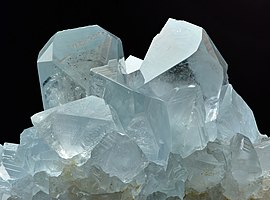天青石
外觀
| 天青石 | |
|---|---|
 潔淨的灰藍色天青石晶體 | |
| 基本資料 | |
| 類別 | 硫酸鹽礦物 |
| 化學式 | SrSO4 |
| IMA記號 | Clt[1] |
| 施特龍茨分類 | 7.AD.35 |
| 晶體分類 | 雙錐體 (mmm) H-M記號:(2/m 2/m 2/m) |
| 晶體空間群 | Pnma |
| 晶胞 | a = 8.359 Å, b = 5.352 Å, c = 6.866 Å; Z = 4 |
| 性質 | |
| 顏色 | 白色、粉紅色、淡綠色、淡棕色、黑色、淡藍色、紅色、灰色;透射光下無色或淺色 |
| 晶體慣態 | 板狀到錐體狀晶體,也有纖維狀、層狀、土狀、塊狀顆粒 |
| 晶系 | 正交晶系 |
| 解理 | {001}完美,{210}良,{010}差 |
| 斷口 | 參差狀 |
| 韌性/脆性 | 脆 |
| 莫氏硬度 | 3 - 3.5 |
| 光澤 | 玻璃光澤,解理珍珠光澤 |
| 條痕 | 白色 |
| 透明性 | 透明到半透明 |
| 比重 | 3.95 - 3.97 |
| 光學性質 | 雙軸 (+) |
| 折射率 | nα = 1.619 - 1.622 nβ = 1.622 - 1.624 nγ = 1.630 - 1.632 |
| 雙折射 | δ = 0.011 |
| 多色性 | 弱 |
| 2V夾角 | 測量: 50° - 51° |
| 色散率 | 中等 r < v |
| 發光性 | 短紫外線=黃、白藍、長紫外線=黃、白藍 |
| 參考文獻 | [2][3][4][5] |
天青石(英語:Celestine[6]或Celestite[7])是一種由硫酸鍶組成的礦物。這種礦物因其偶爾出現的精緻藍色而得名。天青石和菱鍶礦是鍶元素的主要來源。
發現
[編輯]天青石以晶體形式出現,也以緊湊的塊狀和纖維狀形式出現。它主要存在於沉積岩中,通常與礦物石膏、硬石膏和岩鹽有關。 這種礦物遍布世界各地,通常數量很少。在馬達加斯加發現了淡藍色的晶體標本。白色和橙色的變種也出現在英國布里斯托爾的Yate,直到20世紀中葉,它才被提取用於商業目的。[8] 與其他放射蟲的骨骼由硅石組成不同,等輻骨亞綱原生動物的骨骼是由天青石組成的。
在碳酸鹽海相沉積物中,埋藏溶解是公認的天青石沉澱機制。[9]它有時被用作寶石。[10]
-
來自波蘭,Machow礦的天青石
晶洞
[編輯]在一些晶洞中發現了天青石晶體。世界上已知最大的晶洞,最寬處直徑為35英尺(11公尺)的天青石晶洞,位於俄亥俄州普特因灣的伊利湖南巴斯島附近。晶洞已被改造成觀景洞,曾經構成晶洞底部的晶體被移除。晶洞有寬達18英寸(46公分)天青石晶體,估計每個重達300英磅(140公斤)。
天青石晶洞被認為通過替換由硫酸鈣組成的石膏或硬石膏組成的雪花石膏結節而形成。硫酸鈣微溶,但硫酸鍶大多不溶。與硫酸鈣結節接觸的含鍶溶液將鈣溶解掉,留下空洞。鍶立即沉澱為天青石,晶體生長到新形成的空腔中。[11][12][13]
-
天青石晶洞剖面
-
俄亥俄州的水晶洞內
參考資料
[編輯]- ^ Warr, L.N. IMA–CNMNC approved mineral symbols. Mineralogical Magazine. 2021, 85 (3): 291–320 [2022-02-10]. Bibcode:2021MinM...85..291W. S2CID 235729616. doi:10.1180/mgm.2021.43. (原始內容存檔於2021-11-19).
- ^ Mineralienatlas. [2022-04-09]. (原始內容存檔於2022-01-27).
- ^ Handbook of Mineralogy (PDF). [2022-04-09]. (原始內容 (PDF)存檔於2008-09-06).
- ^ Mindat.org. [2007-12-19]. (原始內容存檔於2007-12-11).
- ^ Webmineral data. [2022-04-09]. (原始內容存檔於2014-01-11).
- ^ List of Minerals. 21 March 2011 [2022-04-09]. (原始內容存檔於2021-12-20).
- ^ Nickel, Ernie.; Nichols, Monte. Mineral Names, Redefinitions & Discreditations Passed by the CNMMN of the IMA 網際網路檔案館的存檔,存檔日期May 30, 2008,., Materials Data, 2004, p. 26. Celestine is the approved name for this mineral by the International Mineralogical Association Commission on New Minerals and Mineral Names (CNMMN). Although celestite finds frequent usage in some mineralogical texts, the name has been discredited as a valid mineral name by this organization.
- ^ Beneath our Feet | History of Yate | Home | Discover Yate's History at Yate Heritage Centre. [2022-04-09]. (原始內容存檔於2019-12-30).
- ^ Baker, Paul A.; Bloomer, Sherman H. The origin of celestite in deep-sea carbonate sediments. Geochimica et Cosmochimica Acta. 1988, 52 (2): 335–339. Bibcode:1988GeCoA..52..335B. doi:10.1016/0016-7037(88)90088-9.
- ^ Tables of Gemstone Identification By Roger Dedeyne, Ivo Quintens p.174
- ^ Anenburg, Michael; Bialik, Or; Vapnik, Yevgeny; Chapman, Hazel; Antler, Gilad; Katzir, Yaron; Bickle, Mike. The origin of celestine–quartz–calcite geodes associated with a basaltic dyke, Makhtesh Ramon, Israel. Geological Magazine. 2014, 151 (5): 798–815. Bibcode:2014GeoM..151..798A. S2CID 129529427. doi:10.1017/S0016756813000800.
- ^ Carlson, Ernest. Celestite replacements of evaporites in the Salina Group. Sedimentary Geology. 1987, 54 (1–2): 93–112. Bibcode:1987SedG...54...93C. doi:10.1016/0037-0738(87)90005-4.
- ^ Kile, Daniel; Dayvault, Richard; Hood, William; Hatch, H. Steven. Celestine-Bearing Geodes from Wayne and Emery Counties, Southeastern Utah: Genesis and Mineralogy. Rocks & Minerals. 2015, 90 (4): 314–337. S2CID 130452012. doi:10.1080/00357529.2015.1034489.
外部連結
[編輯]- Celestine. Encyclopædia Britannica 5 (第11版). London. 1911.




